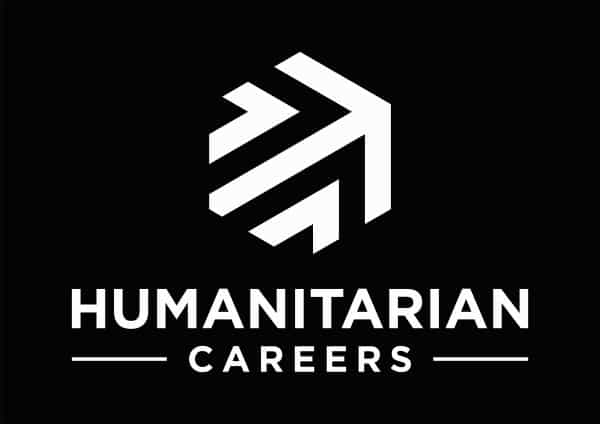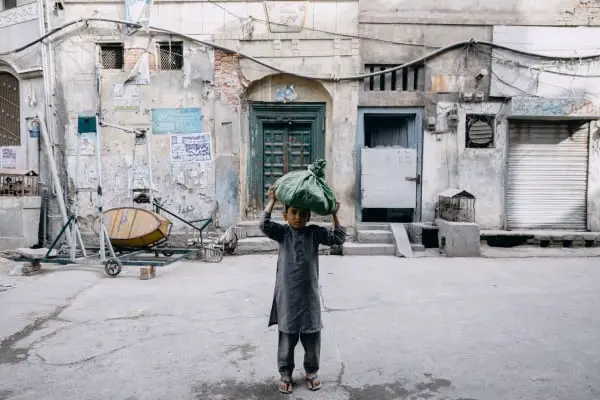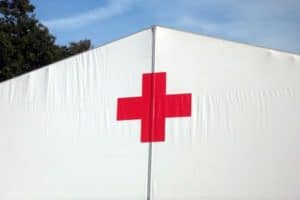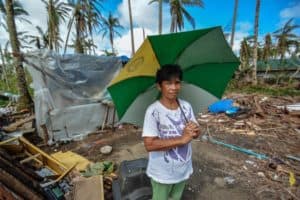This page contains affiliate links. This means if you a follow a link and make a purchase, at no additional cost to you, Humanitarian Careers will receive a commission. Thank you for supporting the site.
Humanitarian aid is given to people affected by crises. The aim of humanitarian aid is to save lives, reduce suffering and help people recover from disasters. We often hear through the news or social media about humanitarian aid being delivered, but what exactly is it? What types of things do people in crises hit areas receive as aid?
To answer this, we’ve given examples of the eleven main types of humanitarian aid. Read on!
Food Distribution
A good example of humanitarian aid is the distribution of food. When communities are hit by crises, conflicts or disasters, people often struggle to access food. Humanitarian aid agencies will distribute food items to people in need to prevent malnutrition and starvation.
There are many examples of food being given as humanitarian aid. Some food is provided as cooked meals or staple food items such as rice, oil and bread is provided to people. The type of food given as humanitarian aid and the method of distribution used are determined by the context the aid is being given in.
There are many types of crises that aid agencies respond to by distributing food. For example, famines and droughts require the urgent delivery of food as aid. Other instances that require the provision of food include refugee camps, conflict settings and areas of extreme poverty.
There are many humanitarian organisations that provide food aid. Some of the major ones include the World Food Programme, Action Against Hunger and Oxfam.
Non-Food Items
Non-food items (NFI) is the technical term given in the humanitarian sector for physical items distributed as aid.
Examples of non-food items given as humanitarian assistance include winter blankets, clothes, sanitation kits, female dignity kits, construction supplies, cooking equipment and items to set-up small business such as sowing machines or tools.
There is a huge range of items that need to be distributed to people affected by poverty, crises or wars. The exact items given by aid agencies depend entirely on the needs of the population. Humanitarian organisations will conduct a needs assessment to determine what non-food items communities require.
Some examples of the types of crises where non-food items may be given as humanitarian assistance include floods, earthquakes, conflicts, refugee camp settings and famines. In fact, almost any humanitarian crises requires the distribution of non-food items.
Almost every humanitarian aid organisation undertakes the distribution of non-food items. Some examples of major aid agencies known for their NFI programming include Oxfam, UNHCR and Save the Children.
Cash
Another example of humanitarian aid is cash. This is where aid agencies directly provide people in need with money.
Cash is fast becoming a major type of humanitarian aid. There are many advantages to aid agencies helping people by directly giving financial assistance. For example, giving cash reduces the costs for humanitarian agencies as expensive procurement, storing and shipping of aid supplies is not needed. Cash assistance is also good for beneficiaries as it allows them to spend the money on their exact individual needs.
There are also wider examples of the benefits of cash as humanitarian assistance. A major factor is that it benefits the local economy, as recipients spend the money in the local market. This also avoids market distortion where aid agencies bring in aid and distribute it for free, meaning people with means do not spend money locally.
Almost all types of humanitarian crises can be responded to with cash assistance, if the local market infrastructure is functioning sufficiently. Some examples of humanitarian agencies that do cash programming are Mercy Corps, Oxfam, ACTED and Danish Refugee Council.
Shelter
Shelter is a major example of humanitarian assistance. When communities are hit by disasters and conflicts often large numbers of people lose their homes. Providing shelter as humanitarian aid helps people either rebuild their houses or gives them temporary places to stay.
There are different examples of how aid agencies can provide shelter as humanitarian aid. In contexts where people’s homes have been damaged but perhaps not destroyed, construction materials can be distributed to help people reconstruct. In other contexts where people may have had to flee their homes because of conflict, an example of shelter as humanitarian aid is the setting-up of refugee camps – giving people temporary shelters.
There are many types of humanitarian emergencies that require aid agencies to provide shelter. Earthquakes, floods, conflicts and migration crises are just some examples of contexts where people require shelter assistance.
Some humanitarian agencies that specialise in providing shelter to people affected by crises include UNHCR, Shelter Box, and Norwegian Refugee Council.
Water, Sanitation and Hygiene Programming
Clean water and good sanitation are vital needs for people affected by crises and disasters. Providing this to affected populations is another example of humanitarian aid.
When communities are hit by disasters or conflicts, people often lose access to basic sanitation and drinkable water. Destruction of infrastructure, forced migration, loss of income and contamination of water supplies can all be reasons for why crises hit people need water, sanitation and hygiene assistance.
In the humanitarian sector, water, sanitation and hygiene work is known as WASH.
There are many examples of how humanitarian agencies can use aid to help people meet their water sanitation, hygiene needs. These include distributing clean water, digging wells and latrines, waste collection and disposal and providing non-food items such as soap, sanitary products and cleaning supplies.
Almost all types of humanitarian crises require aid agencies to provide water, sanitation and hygiene assistance.
Many humanitarian agencies focus on WASH programming. Some examples include Oxfam, WaterAid, CARE International and Solidarités International.
Child Protection
Children are especially vulnerable in a humanitarian crisis. When communities are disrupted by disasters or conflicts the social networks that protect children are impacted, putting children at increased risks of harm, violence, exploitation or abuse.
One example of humanitarian assistance is child protection programming. Aid agencies run projects that aim to help children and their families who are affected by crises. The aim of these interventions is to limit the harm that can come to children, support their families to recover from the crises and provide physical and psychological support to children in need.
Some examples of humanitarian child protection projects include family reunifications, child-friendly spaces, case management, working with detained children and projects to end the use of child soldiers.
Almost all types of humanitarian crises require aid programming in child protection.
There are many humanitarian agencies that work in child protection. Some examples are Save the Children, War Child, Terre de Hommes and UNICEF.
Livelihoods Assistance
Another example of humanitarian aid is livelihoods assistance.
When humanitarian crises hit, people lose jobs, businesses and the ability to provide for themselves and their families. Humanitarian aid as livelihoods assistance aims to help people recover from disasters by giving them tools, training and financial help to rebuild their livelihoods.
There are many examples of the types of work done by aid agencies to rebuild livelihoods. These include cash distributions, trainings, micro-finance projects, distributing supplies and cash for work programmes.
Humanitarian aid projects focusing on livelihoods are often included in longer-term crises responses or as part of development programmes. Examples of chronic crises that often have livelihood responses are refugee and migration contexts, droughts and poverty reduction work.
There are also short-term livelihoods interventions such as to help people recover from sudden onset disasters such as extreme storms, earthquakes or floods.
Many leading humanitarian agencies do livelihoods work. Some examples are Oxfam, Save the Children, Solidarités International and Mercy Corps.
Humanitarian Aid Online Courses
If you want to learn more about humanitarian aid, including more examples, we highly recommend the online course When Disaster Meets Conflict by the Erasmus University Rotterdam. We think it’s one of the best overviews of the humanitarian sector. Follow the link to the course’s page for more information.
The International Humanitarian Law Theory and Practice online course offered by Leiden University in the Netherlands provides a fantastic theoretical overview of humanitarianism. We think it’s one of the top online courses for those who want to understand the basics of international humanitarian law. Click the link to visit the course’s page for more information.
If you are looking to work in humanitarian aid, we highly recommend the online course International Humanitarian and Development Careers. We think it also provides a great overview of the humanitarian aid sector and gives valuable insights for those searching for jobs in humanitarian aid. Follow the link to the course’s page for more information.
Medical Aid
Medical aid is a good example of humanitarian assistance. Many crises require aid agencies to respond with the provision of healthcare.
When a crises, conflict or disaster hits a community, there are extensive requirements for medical assistance. All humanitarian crises cause death and injury and so humanitarian relief must have a focus on health and medicine.
There are many examples of healthcare as humanitarian aid. It can include running health posts, establishing clinics, community health work, and rehabilitating hospitals.
Medical needs in humanitarian emergencies can be huge. Some examples of health projects run by humanitarian organisations include trauma care, surgery, providing drugs, sexual and reproductive health, HIV/aids work and helping people with disabilities.
Another example of medical assistance in humanitarian aid is responding to pandemics. Many Cholera and Ebola outbreaks and the Covid-19 pandemic have all required humanitarian responses.
There are many humanitarian agencies that run health projects. A few examples are Médecins San Frontiere, Médecins du Monde, Premiere Urgence International and the International Medical Corps.
Education
When countries are hit by humanitarian crises, children’s education becomes disrupted. An example of humanitarian assistance is education programming. This is where aid agencies work to provide children schooling who would otherwise go without.
Education as humanitarian aid can be given in many ways. Aid agencies can run entire schools providing larger number of children education. There are also examples of humanitarian organisations subsidising schooling through paying teachers or providing pupils fees. Humanitarian education can also assist with curriculum development and working with the Ministry of Education in crises hit countries.
There are a wide range of examples of humanitarian organisations responding to crises by providing education to children. Earthquakes, conflicts and refugee migrations are all contexts where education programming is common.
Many humanitarian organisations run education projects. Some notable ones include Save the Children, UNICEF and the Norwegian Refugee Council.
Mental Health Projects
People who experience humanitarian crises can have increased mental health needs. Mental health and psycho-social support (MHPSS) is an example of humanitarian aid that works to assist people with their mental health within a humanitarian context.
As a greater enthesis has been placed on mental health in recent years, the humanitarian sector has grown to incorporate MHPSS programming into more responses.
As an example of humanitarian aid, MHPSS projects cover a wide range of activities to help people with different psychological needs. It can include psychological first aid, case management, developing referral pathways, counselling and the prescription of psychotropic drugs.
All humanitarian crises have a mental health impact on the people they affect. Both people whose lives are impacted by the crises, and aid workers who respond in difficult scenarios can require MHPSS support.
Some examples of humanitarian aid organisations that do MHPSS programming are Medecins du Monde, Premiere Urgence International and Action Against Hunger.
Gender-Based Violence Programming
Humanitarian crises affect women extensivity. Gender-based violence increases significantly when communities are hit by disasters or conflicts. Humanitarian emergencies disrupt family and social networks, whilst damaging communities’ structures. This can result in increased violence, exploitation and sexual abuse of women.
An important example of humanitarian aid is gender-based violence programming. Many humanitarian organisations run projects to protect women and help those affected by gender-based violence.
There are a wide range of project types that humanitarian agencies run to assist women affected by crises. These can include the establishment of women’s spaces, case management, setting-up referral pathways, medical assistance and sexual and reproductive health programming.
All humanitarian crises affect women disproportionally.
There are many organisations that provide aid to women affected by humanitarian emergencies. Some examples include ActionAid, Plan International, Save the Children and Oxfam.
If you want to learn more about humanitarian aid, explore our list of the top humanitarian aid online courses here.




